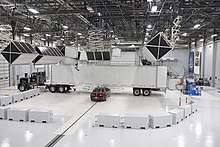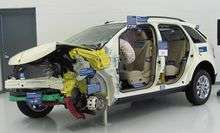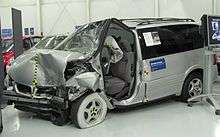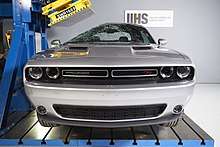Insurance Institute for Highway Safety
The Insurance Institute for Highway Safety (IIHS) is a U.S. nonprofit organization funded by auto insurance companies, established in 1959 and headquartered in Arlington, Virginia. It works to reduce the number of motor vehicle traffic collisions, and the rate of injuries and amount of property damage in the crashes that still occur. It carries out research and produces ratings for popular passenger vehicles as well as for certain consumer products such as child car booster seats. It also conducts research on road design and traffic regulations, and has been involved in promoting policy decisions.[1]

Frontal crash tests




The IIHS evaluates six individual categories, assigning each a "Good", "Acceptable", "Marginal", or "Poor" rating before determining the vehicle's overall frontal impact rating.[2]
Moderate overlap frontal test
The moderate overlap test (formerly frontal offset test), introduced in January 1995,[3] differs from that of the U.S. government's National Highway Traffic Safety Administration (NHTSA) New Car Assessment Program (NCAP) in that its tests are offset. This test exposes 40% of the front of the vehicle to an impact with a deformable barrier at approximately 40 mph (65 km/h).
As with the NHTSA's frontal impact test, vehicles across different weight categories may not be directly compared. This is because the heavier vehicle is generally considered to have an advantage if it encounters a lighter vehicle or is involved in a single-vehicle crash. The IIHS demonstrated this by crashing three midsize sedans with three smaller "Good" rated minicars. For example, three minicars were rated "Poor" in these special offset head-on car-to-car tests in 2009, while the midsize cars rated "Good" or "Acceptable".[4]
Small overlap frontal test
On August 14, 2012, IIHS released the first results for a new test, called "small overlap front test." The new test, which is used in addition to the 40% offset test introduced in 1995, subjects only 25% of the front end of the vehicle to a 40 mph impact against a solid, rounded-off barrier. As a result, it is far more demanding on the vehicle structure than the 40% offset test. In the first round of test, composed of 11 midsized luxury and near-luxury vehicles, most vehicles did poorly; only three vehicles received "good" or "acceptable" ratings.[5]
The rating system is similar to the 40% offset, but has some key differences: hip/thigh and lower leg/foot ratings replace individual ratings for each leg and foot, and full score cannot be attained without deployment of front and side curtain airbags (due to the severe side movement often resulting from this test).[6]
A Medical College of Wisconsin study found small-overlap collisions result in increased head, chest, spine, hip, and pelvis injuries. This sort of collision is common on two-lane roads with two-way traffic where a center median is absent. Single vehicle crashes (into a tree or a pole) account for 40 percent of small-overlap crashes.[7] According to the IIHS, 25% of frontal crash deaths are due to small overlap crashes, with the outer front wheel first to receive the impact forces rather than the more central crash absorbing structure.[8]
The IIHS has since tested family cars,[9] compact cars,[10][11] minicars,[12] small[13] and midsized[14][15] SUVs, minivans,[16] muscle cars[17] and large pickup trucks[18] through the small-overlap test.
In 2017, the IIHS began conducting this test on the passenger side of vehicles.
Side impact test
The IIHS began conducting the side impact test in 2003. In this test, the test vehicle remains stationary while a four-wheeled sled, with a deformable barrier attached, strikes the side of the vehicle at 31 mph (50 km/h). This test is used to simulate the impact of a high-riding pickup or SUV on the subject vehicle.
In 2019, the IIHS began modifying the test by using a heavier sled, changing the barrier design, and increasing the impact speed from 31 to 37 mph (60 km/h). The IIHS cited the current test being unrealistic as the main reason for the modification.[19] The modified test has yet to be officially conducted.
Roof strength test

In the United States rollovers accounted for nearly 25% of passenger vehicle fatalities. Features such as electronic stability control are proven to significantly reduce rollovers and lane departure warning systems may also help. Rollover sensing side curtain airbags also help to minimize injuries in the event of a rollover.[20]
In the test, which was introduced in 2009, the vehicle rests on a platform while an angled metal hydraulic plate pushes on its roof, in the area just above the windows. In order to get the highest rating, the vehicle must withstand a force equivalent to at least four times its curb weight before collapsing 5 in (130 mm).[21]
50th Anniversary crash test
In 2009, the IIHS celebrated its 50th anniversary. To illustrate how much automotive safety has progressed in five decades, IIHS tested a 1959 Chevrolet Bel Air crashing head-on, 40% offset with a 2009 Chevrolet Malibu at 40 mph.[22] It put the video of the crash on the Internet and "the results were no surprise to anyone with a passing familiarity with cars."[23] The Bel Air's occupant compartment was extensively damaged by the crash. Coupled with the car's lack of modern safety features such as airbags and seat belts, this resulted in the crash test dummy in the Bel Air recording forces that would have probably caused fatal injuries to a real driver. They "would not only hit the inside of the car and experience a large (and damaging acceleration) but the car would smash you on the inside."[24] Sophisticated engineering and high-strength steel give modern vehicles a huge advantage.[22]
Head restraint evaluation
This tests the vehicle's driver seat to determine effectiveness of the head restraints.[25] The driver's seat is placed on a sled to mimic rear-end collisions at 20 mph. Rear-end collisions at low to moderate speeds typically do not result in serious injuries but they are common.[26] In 2005 the IIHS estimated 25% of medical costs were related to whiplash injuries.
Frontal collision avoidance evaluation
Vehicle-to-vehicle
In this test, an engineer drives the test car toward a rolling, cushioned box, which is used to simulate an actual car. The ratings, "basic", "advanced", and "superior", are awarded depending on whether the front crash prevention system meets government criteria, and if the system can reduce the speed or avoid the collision at both 12 and 25 mph (19 and 40. km/h).[27]
Vehicle-to-pedestrian
The IIHS runs this test in three different scenarios, each scenario having two different speeds for the tested vehicle.
- 1st scenario: A 180 cm (6 ft) tall adult adult pedestrian walks perpendicular to oncoming traffic, and the tested vehicle must successfully autobrake enough to avoid hitting the pedestrian at 19 and 40 km/h (12 and 25 mph).
- 2nd scenario: A 110 cm (45 in) tall child (average height of a 7-year-old child) darts out from behind two parked vehicles (the one closer to the child is a sedan, and the farther is an SUV), and the tested vehicle must successfully autobrake enough to avoid hitting the dart-out child at 19 and 40 km/h (12 and 25 mph).
- 3rd scenario: The same 180 cm (6 ft) tall adult pedestrian walks parallel to traffic, and the tested vehicle must successfully autobrake enough to avoid hitting the pedestrian at 40 and 60 km/h (25 and 37 mph).[28]
Headlight evaluation
In March 2016, the IIHS released ratings for headlight performance. Their first test involved family cars, and most earned marginal or poor ratings. Only one vehicle, the Toyota Prius V, earned a good rating when equipped with specific headlights.[29] The Institute evaluated headlights for small SUVs 4 months later, and none of the vehicles tested earn a good rating.[30] On October 2016, they released ratings for pickup trucks, and the Honda Ridgeline was the only pickup to earn a good rating on the headlights test when equipped with specific headlights.[31]
Awards
The Top Safety Pick is an annual award to the best-performing cars of the year. To receive a Top Safety Pick, the vehicle must receive "Good" overall marks in the moderate overlap front, driver-side small overlap front, side, roof strength and seat head restraint tests. Vehicles must also be available with headlights rated acceptable or good, a front crash prevention system rated superior or advanced, and receive an acceptable or good rating in the passenger side small overlap test. The Top Safety Pick+ award is given to vehicles that meet all the criteria for a Top Safety Pick, but also are available with good rated headlights and receive a rating of good in the passenger-side small overlap test.[32]
In the media
After a small segment on MotorWeek '91 in which former president Brian O'Neill demonstrated the Institute's bumper crash testing system, the IIHS began to receive national media coverage. When the IIHS began its moderate overlap frontal test program in 1995, Dateline NBC correspondent Lea Thompson was invited to watch its crash tests, and segments about the Institute's crash test programs became a regular feature on Dateline throughout the mid-1990s and 2000s. Other IIHS tests were later covered, including bumper crash tests, side-impact crash tests, and head restraint evaluation tests. Some of these segments are credited for pushing automakers into designing safer cars, such as when the IIHS tested the 1997-2005 GM U platform minivans. They were named the worst performing vehicles it had ever tested, with potentially fatal injuries for the driver. Their successors, offered from 2005–2009, were markedly improved, and received a "Good" rating from the Institute. The 1997-2003 Ford F-150 was later named the 2nd worst performing vehicle, also with potentially fatal injuries for the driver. The redesigned 2004 Ford F-150 received a "Good" rating from the Institute. When Brian O'Neill stepped down as IIHS president in 2006, the IIHS segments were much shorter, and less frequent, until they ended around late-2006, when correspondent Lea Thompson left Dateline NBC. Many of these Dateline segments are available to watch on YouTube.
See also
References
- "Regulatory documents". Iihs.org. Retrieved 2017-10-08.
- Weberillustrations, Bob. "Cars.com". Cars.com. Retrieved 2011-11-13.
- "Frontal crash tests". Iihs.org. Retrieved 2017-10-08.
- "IIHS.org". IIHS.org. 2009-04-14. Retrieved 2011-11-13.
- "IIHS raises the bar with new crash test". Iihs.org. 2012-08-14. Retrieved 2017-10-08.
- "IIHS.org". IIHS.org. 2012-08-14. Retrieved 2012-08-14.
- "New car crash test promises to make a big safety impact". News.consumerreports.org. 2012-08-14. Archived from the original on 2012-10-19. Retrieved 2017-10-08.
- "Honda, Volvo models get high marks in new overlap crash tests". Autonews.com. 2013-03-07. Retrieved 2017-10-08.
- "Family cars trump luxury models in new crash test". Iihs.org. 2012-12-20. Retrieved 2017-10-08.
- "Small overlap front test challenges small cars". Iihs.org. 2013-08-08. Retrieved 2017-10-08.
- "Small car ratings vary in small overlap test". Iihs.org. 2014-07-30. Retrieved 2017-10-08.
- "Minicars fall short in tough frontal crash test". Iihs.org. 2014-02-20. Retrieved 2017-10-08.
- "Redesigned Subaru Forester aces tough new crash test". Iihs.org. 2013-05-16. Retrieved 2017-10-08.
- "Small overlap test stymies midsize SUVs". Iihs.org. 2014-04-08. Retrieved 2017-10-08.
- "Midsize SUVs' ratings are mixed". Iihs.org. 2015-05-12. Retrieved 2017-10-08.
- http://www.iihs.org/iihs/sr/statusreport/article/49/10/1
- "Muscle cars fall short of safety awards". Iihs.org. 2016-05-24. Retrieved 2017-10-08.
- "Pickups struggle with small overlap test". Iihs.org. 2016-04-12. Retrieved 2017-10-08.
- Atiyeh, Clifford (2019-11-21). "IIHS Safety Group Toughens Crucial Crash Test, Will Live-Stream One on Nov. 21". Car and Driver. Retrieved 2019-12-30.
- "Blogs.consumerreports.org". Blogs.consumerreports.org. 2009-03-24. Archived from the original on 2010-05-30. Retrieved 2011-11-13.
- "IIHS debuts new roof strength crash test, small SUVs rated first". Autoblog. Retrieved 2019-12-30.
- Jensen, Christopher (September 17, 2009). "A 2009 Chevy Malibu Destroys a 1959 Bel Air -- Literally". The New York Times. Retrieved January 17, 2018.
- Northrup, Laura (September 23, 2009). "Crash Test Wars: 1959 Chevy Bel Air VS 2009 Chevy Malibu". Consumerist. Retrieved January 17, 2018.
- Allain, Rhett (December 18, 2010). "Crash Test: 2009 Malibu vs. 1959 Bel Air". Wired. Retrieved January 17, 2018.
- "IIHS.org". IIHS.org. Retrieved 2014-05-27.
- "IIHS.org". IIHS.org. Archived from the original on 2011-11-08. Retrieved 2011-11-13.
- "Front crash prevention tests". Iihs.org. Retrieved 2017-10-08.
- https://www.iihs.org/news/detail/new-ratings-address-pedestrian-crashes
- "New IIHS ratings show most headlights are lacking". Iihs.org. 2016-03-30. Retrieved 2017-10-08.
- "Most small SUV headlights rate poor". Iihs.org. 2016-07-12. Retrieved 2017-10-08.
- "Pickups fall short in headlight testing". Iihs.org. 2016-10-25. Retrieved 2017-10-08.
- "IIHS safety ratings". IIHS. Retrieved 2018-01-29.
External links

- Official website